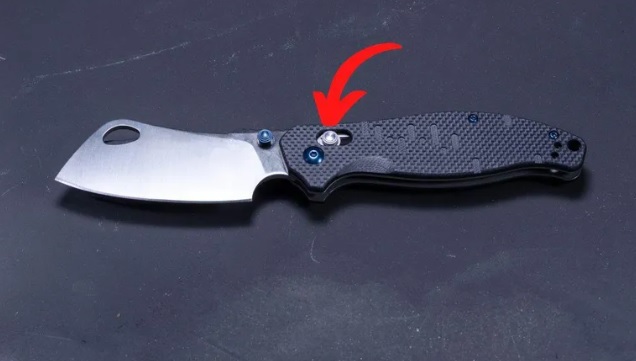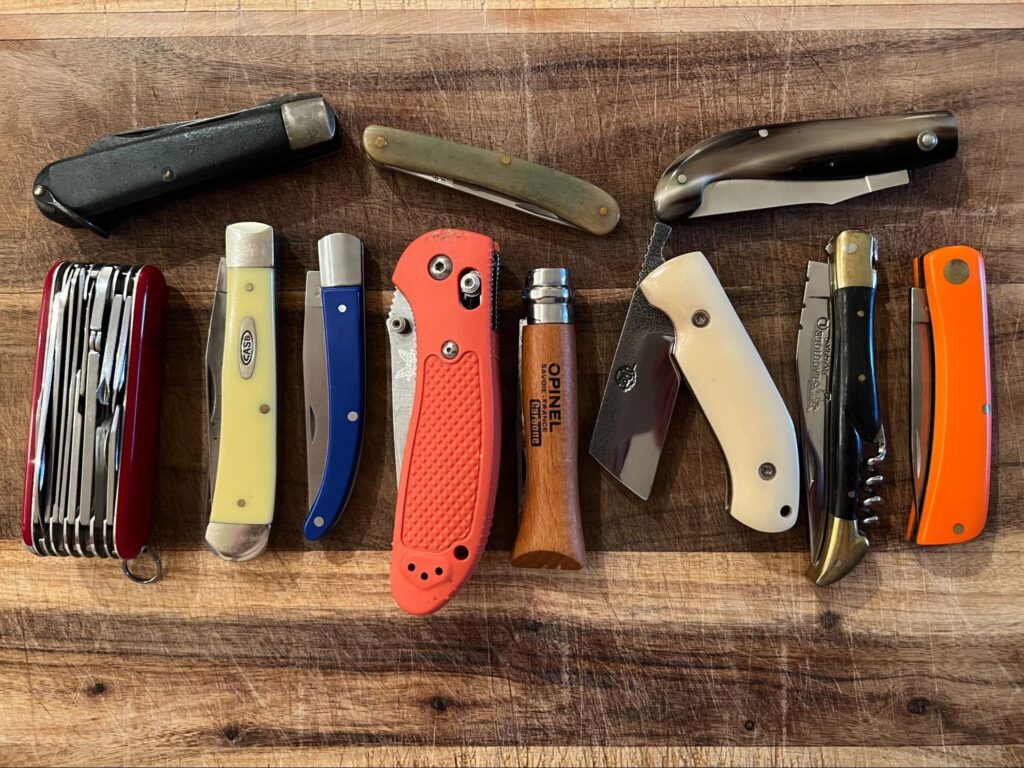In this article, you will discover everything you need to know about safely closing a folding knife.
Summary
ToggleWhether you are a beginner or an experienced user, these tips will help you avoid accidents when closing your knife.
What is a Folding Knife ?
A folding knife, also known as a pocket knife, is a type of knife equipped with a blade that can be folded into the handle for easy transport and storage. Folding knives are very popular for outdoor activities, hiking, fishing, hunting, manual work, and everyday tasks. These portable and compact knives can also be called folding knives, pocket knives, folding blade knives, or EDC (Everyday Carry) knives. Folding knives are available in different sizes, shapes, blade types, and handle materials to meet the needs of each user. They are often equipped with locking mechanisms to ensure user safety when using the knife.
Operation and Mechanism of the Folding Knife :
A folding knife consists of a blade held in place by a pivot hinge and a handle that can be folded for easy transport and storage. The folding mechanism also includes a spring that keeps the knife in the closed or open position and a locking mechanism that prevents the blade from accidentally closing on the user’s fingers. Different types of locking mechanisms include liner locks, back locks, and notch locks. Some folding knives may also have an assisted opening mechanism to facilitate blade deployment.
Types of Pocket Knife Locks :
Most knife locks are relatively easy to understand if you know how they work and what to look for. It shouldn’t take you long to become proficient, even if you are completely new to folding knives.
Folding pocket knives generally come with one of the following locking systems:
- Slip Joint
- Frame Lock
- Liner Lock
- Lockback
- Button Lock
- Axis Lock
- Compression Lock
The locking mechanisms listed above are relatively standard, but there are a number of unique blade locks used only on a few knife models or by certain companies. However, almost all knife locks operate on the same principles as standard locks, so you shouldn’t have too much trouble understanding blade locks not covered here.
If you can open a standard folding knife lock, you can generally understand almost any other knife lock fairly quickly.
Below, I will go over the most popular knife locks and explain precisely how to close and use each type of lock. So, let’s get started!
How to Close a Slip Joint Knife ?

Let’s look at the specific movements and steps you need to follow to correctly open a slip joint pocket knife. Once you are more comfortable, you can start opening your knife with one hand and much more quickly.
- Hold the open knife in your dominant hand, with the pivot point away from your body and the blade facing up.
- Gently grasp the back of the blade with your non-dominant hand (use the nail nick if possible) and apply pressure on the blade until it folds into the handle.
- Be sure to fold the blade completely into the handle before storing or transporting the knife.
Commonly used on traditional-style folding knives, slip joint locking mechanisms rely on downward pressure exerted by the user to prevent the blade from closing.
Slip joint knife blades do not have a locking mechanism to keep them closed. Therefore, to use them, simply lift the blade out of the handle and put it in the working position.
Nothing keeps the blade of a slip joint knife open except the pressure you exert on the blade when using it, so you need to be careful and apply adequate pressure to keep it open. To close a slip joint knife, grasp the back of the open blade and carefully fold it into the handle.
Overall, slip joint knives are some of the simplest locking systems to use, but they also have enormous potential for dangerous accidents. Any downward pressure on the blade when using a slip joint knife will cause the blade to close, which can be very dangerous.
How to Close a Frame Lock Knife ?
Frame locks are common on many folding knives. Therefore, learning how to close this type of locking mechanism can be extremely useful. Let’s go over the specific steps to close a frame lock pocket knife.
- Hold the knife in your dominant hand, with the blade and pivot point facing outward from your body.
- Gently slide your thumb over the handle of the knife and push (or pull, depending on the knife) the frame lock to the side of the handle cavity.
- While holding the frame section to the side with your thumb, use your index finger to push the blade upward towards closing.
- Move your thumb away from the handle and continue using your index finger to push the blade into the handle until it locks.
The frame lock mechanism is a very simple concept that is very easy to open and close, but it is extremely strong. The piece that holds the blade in place when it is open or closed is literally an extension of the knife’s outer frame.
To open and close a frame lock, you move part of the frame to the side to allow the blade to pivot freely. When you release the frame part, it moves back into place to prevent any movement of the knife blade.
How to Close a Liner Lock Knife ?

Just like the frame lock, the liner lock is a slightly less robust locking mechanism that appears in a wide variety of knives. Below, I will explain the steps to close a folding knife equipped with a liner lock system.
- Hold the knife with the blade and pivot point facing outward, away from your body, with your dominant hand.
- Slide the thumb of your dominant hand over the knife handle and move the liner lock to the side of the handle cavity.
- While holding the liner lock to the side of the handle cavity, begin to slightly fold the blade into the handle using your index finger.
- Once you have folded the blade about 1/4 of its length, remove your thumb and fold the blade into the handle cavity until it locks.
A liner lock is almost identical to a frame lock, but the main difference lies in the part of the knife that holds the blade when it locks in place. In the case of a frame lock, the piece that holds the blade in the handle cavity is part of the knife’s outer frame, while in the case of a liner lock, it is an inserted piece that is not part of the frame.
Since the lock is not part of the frame, the liner lock can be considered slightly less durable than the frame lock. However, both locking systems are incredibly durable and resistant, so most people can’t even tell the difference if they use their knives for regular folding knife tasks that don’t require a ridiculous amount of structural resistance.
How to Close a Lockback Knife ?

Another widespread and popular locking system is the lockback. Although still often used on folding hunting knives, decorative knives, and many others, it is somewhat less common than some of the previous systems. Let’s look at the movements and steps to close a lockback knife.
- Hold the lockback knife with your dominant hand, the blade pointing outward.
- Use the thumb of your dominant hand to press the blade release mechanism located at the back of the handle, near the butt of the knife (it should be an exposed metal part that looks like part of the knife’s tang).
- While holding the blade trigger at the back of the handle, use your non-dominant hand to start folding the blade towards its closed position.
- Release the lever and close the blade until it locks into the handle cavity.
Commonly used on traditional-style folding hunting knives, lockback locking systems are sturdy and rarely unlock accidentally. You need to put in a lot of thought and effort to close a lockback knife, making them suitable for intense tasks that could be dangerous if the blade inadvertently unlocked.
The lockback knife locking system is relatively simple but very reliable. On a lockback knife, a metal piece runs along the back of the handle and holds the blade open or closed thanks to a strong spring.
When the release mechanism on the knife handle is pressed, it releases the spring and allows the blade to open or close. The spring holds the blade firmly in place when the trigger is not pressed, allowing the knife to be used without fear of unexpected closure.
How to Close a Button Lock Knife ?

Often found on stiletto-style knives or other spring-loaded folding knives, the button lock is an innovative locking system that many people find desirable and flashy. Let’s quickly look at the specific steps to safely and quickly close a button lock knife.
- Start by holding the knife in your dominant hand, with the release button on the handle facing up and the blade pointing outward.
- Use your dominant thumb to firmly press the release button on the handle.
- While continuing to press the button with your thumb, use your other hand to fold the blade towards its closed position.
- Once the blade is closed about 1/4 of its length, release the button and continue closing the blade until it locks into the handle cavity.
Button locks can be excellent due to their quick and easy blade deployment, but you need to keep some safety issues in mind. After all, a simple press of a button can deploy the blade in your pocket or when you don’t expect it.
Commonly used on various lockback knives and rapid deployment knives, the button lock is a highly appreciated blade locking system, but it has some flaws. For more information on lockback knives, check out my article on the differences between lockback knives and folding knives.
When you press the blade release button on a button lock knife, a spring is triggered and quickly opens the knife blade. Depending on the spring’s strength, button knives can open relatively slowly or at breakneck speed.
This opening speed means button knives are illegal or restricted in many areas and can lead to safety and practicality issues. Be sure to stay safe and exercise great caution when closing a button lock knife.
How to Close a Bar Lock Knife (Benchmade Axis Lock) ?

Lockback knives are very popular on everyday knives due to their smooth operation and extremely secure mechanism. Let’s look at the steps to close this type of locking mechanism.
- Hold the knife in your dominant hand, the blade pointing outward and the thumb stud and axis lock buttons facing upward.
- Use your thumb and index finger to simultaneously pull both axis lock buttons towards the center of the handle.
- While continuing to hold the axis lock buttons towards the center of the handle, start folding the blade towards its closed position with your other hand.
- Once the blade is closed about 1/4 of its length, release the axis lock buttons and continue closing the blade until it locks into the handle cavity.
Some of the most robust and popular locks on everyday knives are bar locks. Bar locks are named after the small metal bar or rod that runs along the knife handle and keeps the blade in position.
The specific operation of a bar lock can vary slightly from one company to another, but they all operate in very similar ways. The Benchmade Axis lock is probably the most common bar lock on the market, but there are many similar systems.
The Benchmade Axis lock system is known for its ease of use and durability. Its powerful mechanism ensures that the blade remains securely in place until the user decides to fold it. These locks are designed to withstand heavy use, making them ideal for everyday carry knives.
In summary, understanding the various locking mechanisms of folding knives is crucial for their safe and effective use. From slip joints to bar locks, each system has its own unique features and steps for closing. By following the steps outlined above for each type of lock, you can ensure safe handling and storage of your folding knife.
How to Close Other Types of Folding Knives ?

There are literally hundreds (thousands?!) of different blade locking mechanisms, and you will likely encounter some that I haven’t covered over your lifetime. However, the mechanisms mentioned above should cover the vast majority of knives you will come across, so you should be well-prepared if you learn the seven locking mechanisms mentioned above.
Here are some other types of blade locking mechanisms:
- External Toggle
- Fulcrum Action
- Rollock
- Snap Lock
- Out-The-Front (OTF)
- Out-The-Side (OTS)
- And many more!
The unique and unusual locking mechanisms that do not belong to the main mechanisms I have discussed are generally relatively brand-specific and uncommon to find.
The best way to learn how to close these unique locking mechanisms is to visit the brand’s website, talk to the person you bought the knife from, watch online videos, follow the instructions provided with the knife, or experiment with the knife until it closes (make sure to be careful!).
Safe and Effective Use of a Folding Knife
In summary, it is important to understand the different parts of a folding knife and know how to handle them safely to close the knife. Be sure to take the time to learn the different closing techniques and practice regularly to improve your skill. Using a folding knife can be very practical, but it is important to never underestimate the potential risks associated with improper use. Always follow safety guidelines and take necessary measures to minimize the risk of accidents. With responsible practice and use, you can fully enjoy the benefits of a folding knife in many situations.

